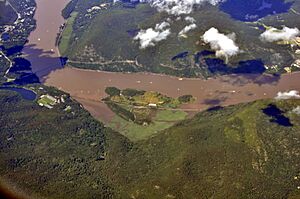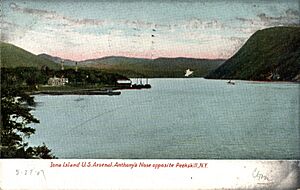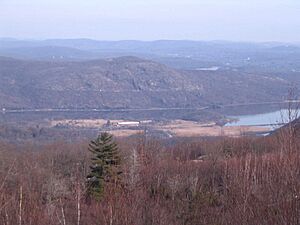Iona Island (New York) facts for kids

View of Iona Island from atop Bear Mountain
|
|
|
Location of Iona Island in New York State
|
|
| Geography | |
|---|---|
| Location | Hudson River |
| Coordinates | 41°18′14″N 73°58′38″W / 41.30389°N 73.97722°W |
| Area | 556 acres (225 ha) |
| Highest elevation | 72 ft (21.9 m) |
| Administration | |
| State | New York |
| County | Rockland County |
| Town | Stony Point |
| Owner | |
| Designated: | 1974 |
Iona Island is a 556-acre island located in the Hudson River in Stony Point, New York. It sits on the river's west bank. The island is about 1 mile south of the Bear Mountain Bridge. It is separated from the Hudson's western shore by mudflats and freshwater tidal marshes.
Iona Island is part of Bear Mountain State Park. From 1899 to 1947, the island was used as a large U.S. Navy ammunition storage area. In May 1974, the island and its nearby marsh became a National Natural Landmark. It is also part of the Hudson River National Estuarine Research Reserve. Today, Iona Island is mainly a bird sanctuary. It is especially known as a winter home for bald eagles.
Contents
Exploring Iona Island's Geography
Iona Island has active railroad tracks running through it. You can reach the island by a causeway that connects it to U.S. Route 9W. This causeway is near Doodletown in Bear Mountain State Park. The Palisades Interstate Park Commission helps maintain the island.
The southeastern part of the island is called Round Island. It used to be separated by marshes. In the early 1900s, it was connected to the main Iona Island with added land. A hill on the western side, south of the causeway, was once known as Courtland Island. Snake Hole Creek starts in the low marshes in the middle of the island. It flows south and then east to reach the Hudson River. This creek separates the marshes of Salisbury Meadow from Ring Meadow.
A Look at Iona Island's History

Native Americans spent their summers fishing from Iona Island. They called the island Wa-na-ka-wagh-kin, which means "good land." You can see artifacts found on Iona Island at the Bear Mountain Trailside Museum and Zoo. In 1683, the Van Cortlandt family bought the land from the native people.
The island was first known as Salisbury Island. Later, it was called Weyant's Island after a local family. It was also known as Beveridge's Island. British troops occupied the island during the American Revolutionary War.
In 1847, John Beveridge bought the island for his son-in-law, Dr. E. W. Grant. Grant renamed it Iona Island. He planted Iona grapes and fruit trees there. During the Civil War, Grant supplied the Union army with his produce. In 1868, his creditors took over the island.
A group of investors bought the island and turned it into a summer resort. Grant's mansion became a hotel. The investors added an amusement park with a carousel, Ferris wheel, and dance floor. There was also a pavilion and picnic grounds. A dock allowed steamboats to bring visitors from New York City and New Jersey. The construction of the West Shore Railroad across the island in 1882 made it even easier for tourists to visit.
In 1899, the U.S. Navy bought the island. They used it as a naval ammunition depot. At that time, it became one of the largest ammunition facilities in the country. On November 4, 1903, an explosion happened at the site. It killed six workers and broke windows in Peekskill, three miles away.
The depot supplied many weapons for both World War I and World War II. It stayed in service until 1947. About five of the original 164 arsenal buildings are still there. The park now uses them for storage. After World War II, until the early 1970s, many decommissioned warships were anchored near the island. This was known as the "mothball fleet."
The Palisades Interstate Park Commission bought the island in 1965. In 1974, the National Park Service named it a National Natural Landmark. Iona Island is now an active wildlife sanctuary. You can visit it by using the causeway off Route 9W. You can also view the island and its wildlife from overlooks on nearby Route 6. There are also overlooks within Bear Mountain State Park. You cannot canoe or kayak in the marsh itself. However, free guided canoeing programs to the marsh are offered during the summer.
Wildlife on Iona Island
In September 2000, the New York State Museum and the New York State Biodiversity Research Institute studied the island's wildlife. This type of study is called a bioblitz.
Bird Species Found on Iona Island
Many different bird species have been identified on Iona Island. Some of these include:
- American bittern
- American kestrel
- Barn swallow
- Belted kingfisher
- Bobolink
- Canada goose
- Cliff swallow
- Eastern bluebird
- Eastern kingbird
- Field sparrow
- Least bittern
- Mute swan
- Marsh wren
- Northern harrier
- Osprey
- Pied-billed grebe
- Prairie warbler
- Red-tailed hawk
- Red-winged blackbird
- Song sparrow
- Virginia rail
- Warbling vireo
- Wood duck





